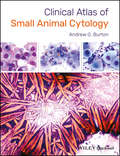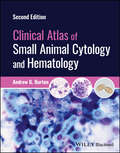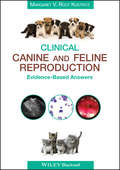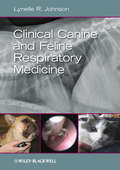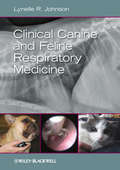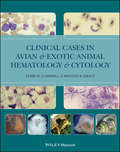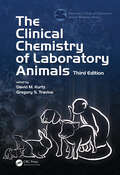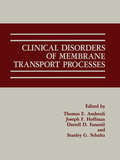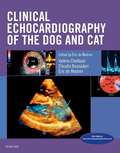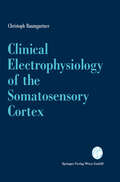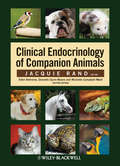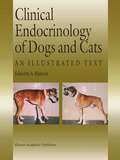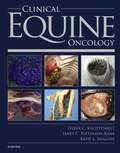- Table View
- List View
Clinical Atlas of Canine and Feline Ophthalmic Disease
by Douglas W. EssonClinical Atlas of Canine and Feline Ophthalmic Disease provides an image-rich resource for diagnosing and treating ophthalmic conditions in clinical practice. • Presents more than 600 high-quality color photographs depicting commonly encountered ocular conditions in dogs and cats • Includes multiple images for each disease to show varying presentations • Organized for easy reference, covering the most commonly encountered conditions first • Designed for daily use in the busy clinical setting, allowing practitioners to quickly find and compare images as they see cases • Provides a concise summary of the most clinically relevant information on diagnosing and managing ophthalmic disease
Clinical Atlas of Canine and Feline Ophthalmic Disease
by Douglas W. EssonClinical Atlas of Canine and Feline Ophthalmic Disease provides an image-rich resource for diagnosing and treating ophthalmic conditions in clinical practice. • Presents more than 600 high-quality color photographs depicting commonly encountered ocular conditions in dogs and cats • Includes multiple images for each disease to show varying presentations • Organized for easy reference, covering the most commonly encountered conditions first • Designed for daily use in the busy clinical setting, allowing practitioners to quickly find and compare images as they see cases • Provides a concise summary of the most clinically relevant information on diagnosing and managing ophthalmic disease
Clinical Atlas of Canine and Feline Ophthalmic Disease
by Douglas W. Esson Sara CalvareseClinical Atlas of Canine and Feline Ophthalmic Disease Complete reference work for diseases and conditions in dogs and cats pertaining to the eye Clinical Atlas of Canine and Feline Ophthalmic Disease is a practical and user-friendly reference of common ocular diseases and conditions. Maintaining an image-heavy approach, the book presents multiple high-quality color photographs to depict each condition and is carefully organized to make it easy to find information. Sample topics included in the significantly expanded and updated new edition include: Basic ophthalmic anatomy & physiology Normal anatomical variations The ocular examination Basic ophthalmic pharmacology Diseases of the globe & orbit Diseases of the conjunctiva, nasolacrimal system & third eyelid Veterinary and animal science students, general canine and feline practitioners as well as interns, residents and specialists in a variety of areas can use this easily-accessible reference work to gain insight into a wide variety of ocular diseases affecting dogs and cats.
Clinical Atlas of Small Animal Cytology
by Andrew G. BurtonClinical Atlas of Small Animal Cytology provides an essential guide for interpreting cytologic samples to diagnose small animal patients. Features photographs of diseases with a diagnosis confirmed by pathognomonic cytologic features, histopathology, special stains, microbial culture, or other confirmatory tests Emphasizes characteristic features of each disease and distinguishing features Provides multiple images to differentiate cells from lesions that could look similar Presents more than 500 representative high-quality images
Clinical Atlas of Small Animal Cytology
by Andrew G. BurtonClinical Atlas of Small Animal Cytology provides an essential guide for interpreting cytologic samples to diagnose small animal patients. Features photographs of diseases with a diagnosis confirmed by pathognomonic cytologic features, histopathology, special stains, microbial culture, or other confirmatory tests Emphasizes characteristic features of each disease and distinguishing features Provides multiple images to differentiate cells from lesions that could look similar Presents more than 500 representative high-quality images
Clinical Atlas of Small Animal Cytology and Hematology
by Andrew G. BurtonClinical Atlas of Small Animal Cytology and Hematology A comprehensive image-based reference to all aspects of small animal cytology and hematology, including sample collection and handling Clinical Atlas of Small Animal Cytology and Hematology, Second Edition is an essential, comprehensive resource for all veterinary professionals preparing and evaluating cytology and blood samples. Featuring hundreds of large, high-quality images, this fully updated new edition provides an even more extensive collection of exceptional photomicrographs, accompanied by detailed descriptions, figure legends and annotations to guide readers through the diagnostic process. The Second Edition adds an extensive new hematology section, new chapters detailing sample acquisition and preparation, and many new diseases across all chapters. Each section provides a detailed description of the microscopic appearance, clinical considerations, and prognosis for each disease, using a bullet point format to promote rapid review for efficient, evidence-based clinical decision making. Clinical Atlas of Small Animal Cytology and Hematology features: More than 750 high-quality cytology and hematology images 6 new chapters, including detailed sections on sample acquisition and the preparation and staining of cytology and hematology slides A comprehensive hematology section including an easy-to-follow blood smear interpretation guide, and detailed chapters describing erythrocytes, leukocytes, platelets and background features Updated cytology sections with new diseases and images in all chapters Easy to use, with superior quality images and detailed yet succinct clinical information, Clinical Atlas of Small Animal Cytology and Hematology is a powerful resource to help improve confidence and skill in the interpretation of cytology and hematology samples, and in turn positively impact patient care and outcomes.
Clinical Atlas of Small Animal Cytology and Hematology
by Andrew G. BurtonClinical Atlas of Small Animal Cytology and Hematology A comprehensive image-based reference to all aspects of small animal cytology and hematology, including sample collection and handling Clinical Atlas of Small Animal Cytology and Hematology, Second Edition is an essential, comprehensive resource for all veterinary professionals preparing and evaluating cytology and blood samples. Featuring hundreds of large, high-quality images, this fully updated new edition provides an even more extensive collection of exceptional photomicrographs, accompanied by detailed descriptions, figure legends and annotations to guide readers through the diagnostic process. The Second Edition adds an extensive new hematology section, new chapters detailing sample acquisition and preparation, and many new diseases across all chapters. Each section provides a detailed description of the microscopic appearance, clinical considerations, and prognosis for each disease, using a bullet point format to promote rapid review for efficient, evidence-based clinical decision making. Clinical Atlas of Small Animal Cytology and Hematology features: More than 750 high-quality cytology and hematology images 6 new chapters, including detailed sections on sample acquisition and the preparation and staining of cytology and hematology slides A comprehensive hematology section including an easy-to-follow blood smear interpretation guide, and detailed chapters describing erythrocytes, leukocytes, platelets and background features Updated cytology sections with new diseases and images in all chapters Easy to use, with superior quality images and detailed yet succinct clinical information, Clinical Atlas of Small Animal Cytology and Hematology is a powerful resource to help improve confidence and skill in the interpretation of cytology and hematology samples, and in turn positively impact patient care and outcomes.
Clinical Biochemistry in Hepatobiliary Diseases: Proceedings of the International Satellite Symposium, Bologna, Italy, 1988 (Progress in Clinical Biochemistry and Medicine #8)
by C. Armanino Y. Artur N. Blanckaert G. Castaldo D. Festi J. Fevery M. M. Galteau J. Griffiths A. Minutello D. W. Moss M. Muraca I.W. Percy-Robb R. Rizzoli A. Roda E. Roda S. B. Rosalki L. Sacchetti F. Salvatore G. J. Sanderink F. Schiele G. Siest P. Simoni F. Vanstapel M. Wellmann M. WernerThe clinical biochemistry ofhepatobiliary diseases is very widely studied, and publica tions abound on this topic. However, there is no recent publication that provides a comprehensive collection of the various leading aspects that go to make up this complex theme. Therefore, we thought it useful to gather together a few scientists whose work has focused on the various clinical biochemistry-aspects of these disorders in order that they might discuss their experience and expertise. The aim of the International Satellite Symposium on Clinical Biochemistry in Hepatobiliary Disease, in addition to reviewing the individual aspects, was to describe the state-of-the-art so as to provide useful data for laboratory scientists and also for physicians working in the field of hepatobiliary diseases, and these two aims are clearly reflected in the chapters of this volume. The volume opens with an introductory chapter that gives a general overview of the various aspects of the clinical biochemistry of these disorders, while the closing chapter deals with an important aspect that deserves to be increasingly emphasized in laboratory medicine, i.e., strategies to integrate information coming from the laboratory to make them more useful for clinical diagnosis.
Clinical Canine and Feline Reproduction: Evidence-Based Answers
by Margaret V. Root KustritzClinical Canine and Feline Reproduction: Evidence-Based Answers provides quick, reliable answers to the most common questions in canine and feline reproductive and pediatric practice. Written using an innovative question-and-answer format, each answer is designed for quick reference, with the best references listed for further information as needed. Based on the author’s years of experience answering questions on reproduction and pediatrics, Clinical Canine and Feline Reproduction allows the practicing veterinarian to rapidly find and apply evidence-based answers from the scientific literature to their clinical questions.
Clinical Canine and Feline Reproduction: Evidence-Based Answers
by Margaret V. Root KustritzClinical Canine and Feline Reproduction: Evidence-Based Answers provides quick, reliable answers to the most common questions in canine and feline reproductive and pediatric practice. Written using an innovative question-and-answer format, each answer is designed for quick reference, with the best references listed for further information as needed. Based on the author’s years of experience answering questions on reproduction and pediatrics, Clinical Canine and Feline Reproduction allows the practicing veterinarian to rapidly find and apply evidence-based answers from the scientific literature to their clinical questions.
Clinical Canine and Feline Respiratory Medicine
by Lynelle R. JohnsonClinical Canine and Feline Respiratory Medicine provides reliable information on the diagnosis and management of respiratory disease in a user-friendly format. With an emphasis on the features of the history and physical examination that aid in efficient diagnostic planning, the book is an accessible, readable resource for optimizing treatment of patients with diseases of the respiratory tract. Offering comprehensive, accessible coverage of respiratory disorders, Clinical Canine and Feline Respiratory Medicine is a useful practice guide and study aid for general practitioners and veterinary students. Beginning with introductory chapters on the localization of disease, diagnostics, and therapeutics, the heart of the book focuses on the full range of respiratory diseases, including nasal disorders, diseases of airways, parenchymal diseases, pleural and mediastinal diseases, and vascular disorders. Each chapter takes a common format with diseases subdivided by etiology into structural, infectious, inflammatory, and neoplastic disorders. Clinical Canine and Feline Respiratory Medicine is a useful tool for students and practitioners engaged in studying, diagnosing, and treating respiratory disease.
Clinical Canine and Feline Respiratory Medicine
by Lynelle R. JohnsonClinical Canine and Feline Respiratory Medicine provides reliable information on the diagnosis and management of respiratory disease in a user-friendly format. With an emphasis on the features of the history and physical examination that aid in efficient diagnostic planning, the book is an accessible, readable resource for optimizing treatment of patients with diseases of the respiratory tract. Offering comprehensive, accessible coverage of respiratory disorders, Clinical Canine and Feline Respiratory Medicine is a useful practice guide and study aid for general practitioners and veterinary students. Beginning with introductory chapters on the localization of disease, diagnostics, and therapeutics, the heart of the book focuses on the full range of respiratory diseases, including nasal disorders, diseases of airways, parenchymal diseases, pleural and mediastinal diseases, and vascular disorders. Each chapter takes a common format with diseases subdivided by etiology into structural, infectious, inflammatory, and neoplastic disorders. Clinical Canine and Feline Respiratory Medicine is a useful tool for students and practitioners engaged in studying, diagnosing, and treating respiratory disease.
Clinical Cases in Avian and Exotic Animal Hematology and Cytology (Coursesmart Ser.)
by Terry Campbell Krystan R. GrantClinical Cases in Avian and Exotic Animal Hematology and Cytology demonstrates how to use hemic cytology and cytodiagnosis as part of the assessment of an exotic animal patient, taking the reader through nearly 100 actual clinical cases. With a focus on cytological interpretation, the hands-on, practical approach facilitates learning, teaching, and comprehension. Well illustrated throughout, Clinical Cases in Avian and Exotic Animal Hematology and Cytology is a helpful guide for exotics veterinarians, zoo and aquarium veterinarians, and veterinary hematologists.
Clinical Cases in Avian and Exotic Animal Hematology and Cytology
by Terry Campbell Krystan R. GrantClinical Cases in Avian and Exotic Animal Hematology and Cytology demonstrates how to use hemic cytology and cytodiagnosis as part of the assessment of an exotic animal patient, taking the reader through nearly 100 actual clinical cases. With a focus on cytological interpretation, the hands-on, practical approach facilitates learning, teaching, and comprehension. Well illustrated throughout, Clinical Cases in Avian and Exotic Animal Hematology and Cytology is a helpful guide for exotics veterinarians, zoo and aquarium veterinarians, and veterinary hematologists.
The Clinical Chemistry of Laboratory Animals
by David M. Kurtz Gregory S. TravlosKey features: Serves as the detailed, authoritative source of the clinical chemistry of the most commonly used laboratory animals Includes detailed chapters dedicated to descriptions of clinical chemistry-related topics specific to each laboratory species as well as organ/class-specific chapters Presents information regarding evaluation and interpretation of a variety of individual clinical chemistry end points Concludes with detailed chapters dedicated to descriptions of statistical analyses and biomarker development of clinical chemistry-related topics Provides extensive reference lists at the end of each chapter to facilitate further study Extensively updated and expanded since the publication of Walter F. Loeb and Fred W. Quimby’s second edition in 1999, the new The Clinical Chemistry of Laboratory Animals, Third Edition continues as the most comprehensive reference on in vivo animal studies. By organizing the book into species- and organ/class-specific chapters, this book provides information to enable a conceptual understanding of clinical chemistry across laboratory species as well as information on evaluation and interpretation of clinical chemistry data relevant to specific organ systems. Now sponsored by the American College of Laboratory Animal Medicine (ACLAM), this well-respected resource includes chapters on multiple laboratory species and provides pertinent information on their unique physiological characteristics, methods for sample collection, and preanalytical sources of variation for the particular species. Basic methodology for common procedures for each species is also discussed. New Chapters in the Third Edition Include: The Laboratory Zebrafish and Other Fishes Evaluation of Cardiovascular and Pulmonary Function and Injury Evaluation of Skeletal Muscle Function and Injury Evaluation of Bone Function and Injury Vitamins Development of Biomarkers Statistical Methods The Clinical Chemistry of Laboratory Animals, Third Edition is intended as a reference for use by veterinary students, clinical veterinarians, verterinary toxicologists, veterinary clinical pathologists, and laboratory animal veterinarians to aid in study design, collection of samples, and interpretation of clinical chemistry data for laboratory species.
The Clinical Chemistry of Laboratory Animals
by David M. Kurtz Gregory S. TravlosKey features: Serves as the detailed, authoritative source of the clinical chemistry of the most commonly used laboratory animals Includes detailed chapters dedicated to descriptions of clinical chemistry-related topics specific to each laboratory species as well as organ/class-specific chapters Presents information regarding evaluation and interpretation of a variety of individual clinical chemistry end points Concludes with detailed chapters dedicated to descriptions of statistical analyses and biomarker development of clinical chemistry-related topics Provides extensive reference lists at the end of each chapter to facilitate further study Extensively updated and expanded since the publication of Walter F. Loeb and Fred W. Quimby’s second edition in 1999, the new The Clinical Chemistry of Laboratory Animals, Third Edition continues as the most comprehensive reference on in vivo animal studies. By organizing the book into species- and organ/class-specific chapters, this book provides information to enable a conceptual understanding of clinical chemistry across laboratory species as well as information on evaluation and interpretation of clinical chemistry data relevant to specific organ systems. Now sponsored by the American College of Laboratory Animal Medicine (ACLAM), this well-respected resource includes chapters on multiple laboratory species and provides pertinent information on their unique physiological characteristics, methods for sample collection, and preanalytical sources of variation for the particular species. Basic methodology for common procedures for each species is also discussed. New Chapters in the Third Edition Include: The Laboratory Zebrafish and Other Fishes Evaluation of Cardiovascular and Pulmonary Function and Injury Evaluation of Skeletal Muscle Function and Injury Evaluation of Bone Function and Injury Vitamins Development of Biomarkers Statistical Methods The Clinical Chemistry of Laboratory Animals, Third Edition is intended as a reference for use by veterinary students, clinical veterinarians, verterinary toxicologists, veterinary clinical pathologists, and laboratory animal veterinarians to aid in study design, collection of samples, and interpretation of clinical chemistry data for laboratory species.
Clinical Data Analysis on a Pocket Calculator: Understanding the Scientific Methods of Statistical Reasoning and Hypothesis Testing (SpringerBriefs in Statistics #0)
by Ton J. Cleophas Aeilko H. ZwindermanIn medical and health care the scientific method is little used, and statistical software programs are experienced as black box programs producing lots of p-values, but little answers to scientific questions. The pocket calculator analyses appears to be, particularly, appreciated, because they enable medical and health professionals and students for the first time to understand the scientific methods of statistical reasoning and hypothesis testing. So much so, that it can start something like a new dimension in their professional world. In addition, a number of statistical methods like power calculations and required sample size calculations can be performed more easily on a pocket calculator, than using a software program. Also, there are some specific advantages of the pocket calculator method. You better understand what you are doing. The pocket calculator works faster, because far less steps have to be taken, averages can be used. The current nonmathematical book is complementary to the nonmathematical "SPSS for Starters and 2nd Levelers" (Springer Heidelberg Germany 2015, from the same authors), and can very well be used as its daily companion.
Clinical Disorders of Membrane Transport Processes
by Thomas E. Andreoli Darrell D. Fanestil Joseph F. Hoffman Stanley G. SchultzClinical Disorders of Membrane Transport Processes is a softcover book containing a portion of Physiology of Membrane Disorders (Second Edition). The parent volume contains six major sections that deal with general aspects of the physiology of transport processes and specific aspects of transport processes in cells and in organized cellular systems, namely epithelia. This text contains the last section, which deals with the application of the physiology of transport processes to the understanding of clinical disorders. We hope that this smaller volume will be helpful to individuals particularly interested in clinical derangements of membrane transport processes. THOMAS E. ANDREOLI JOSEPH F. HOFFMAN DARRELL D. FANESTIL STANLEY G. SCHULTZ Vll Preface to the Second Edition The second edition of Physiology of Membrane Disorders represents an extensive revision and a considerable expansion of the fIrst edition. Yet the purpose of the second edition is identical to that of its predecessor, namely, to provide a rational analysis of membrane transport processes in individual membranes, cells, tissues, and organs, which in tum serves as a frame of reference for rationalizing disorders in which derangements of membrane transport processes playa cardinal role in the clinical expression of disease. As in the fIrst edition, this book is divided into a number of individual, but closely related, sections. Part V represents a new section where the problem of transport across epithelia is treated in some detail. Finally, Part VI, which analyzes clinical derangements, has been enlarged appreciably.
Clinical Echocardiography of the Dog and Cat - E-Book
by Eric de Madron Valérie Chetboul Claudio BussadoriCovering both classical modalities of echocardiography and newer techniques, Clinical Echocardiography of the Dog and Cat shows how to assess, diagnose, and treat canine and feline heart disease. A clinical approach demonstrates how these modalities may be used to acquire images, and then how you can recognize and identify patterns, relate them to different diseases, and manage patient care with those findings. The print book includes a companion website with 50 videos of cardiac ultrasound exams and procedures. Written by veterinary cardiology specialists and echocardiographers Eric de Madron, Valerie Chetboul, and Claudio Bussadori, this indispensable echocardiology resource is ideal for general practitioner veterinarians as well as specialists, including cardiologists and radiologists.Dedicated coverage of canine and feline echocardiography emphasizes a more in-depth discussion of cardiac ultrasound, including the newest ones such as Tissue Doppler and speckle tracking imaging, and transesophageal and 3D echocardiography.A practical, clinical approach shows how these echocardiographic modalities are not just research tools, but useful in diagnosing and staging heart disease in day-to-day practice. Book plus website consolidates offers current information into a single cohesive source covering classical modalities and newer techniques, as well as updates relating to normal echocardiographic examinations and values.50 videos on the companion website demonstrate how to perform echocardiography procedures, illustrating points such as swirling volutes, color flow display of blood flows, dynamic collapses secondary to pericardial effusion, and tumors flicking in and out of the echocardiographic field. A section on presurgical assessment helps you assess risk and prepare for catheter-based correction of cardiac defects — accurate measurements and proper device selection are key to a successful procedure.Over 400 full-color illustrations and 42 summary tables help you achieve precise, high-quality imaging for accurate assessment, including photographs of cadaver animal specimens to clarify the relationship between actual tissues in health and disease and their images.
Clinical Electrophysiology of the Somatosensory Cortex: A Combined Study Using Electrocorticography, Scalp-EEG, and Magnetoencephalography
by Christoph BaumgartnerClinical Endocrinology of Companion Animals
by Jacquie RandClinical Endocrinology of Companion Animals offers fast access to clinically relevant information on managing the patient with endocrine disease. Written by leading experts in veterinary endocrinology, each chapter takes the same structure to aid in the rapid retrieval of information, offering information on pathogenesis, signalment, clinical signs, diagnosis, differential diagnosis, treatment, prognosis, and prevention for a broad list of endocrine disorders. Chapters begin with brief summaries for quick reference, then delve into greater detail. With complete coverage of the most common endocrine diseases, the book includes chapters on conditions in dogs, cats, horses, ferrets, reptiles, and other species. Clinical Endocrinology of Companion Animals is a highly practical resource for any veterinarian treating these common diseases.
Clinical Endocrinology of Companion Animals
by Jacquie Rand Ellen Behrend Danielle Gunn-Moore Michelle Campbell-Ward Danièlle Gunn-MooreClinical Endocrinology of Companion Animals offers fast access to clinically relevant information on managing the patient with endocrine disease. Written by leading experts in veterinary endocrinology, each chapter takes the same structure to aid in the rapid retrieval of information, offering information on pathogenesis, signalment, clinical signs, diagnosis, differential diagnosis, treatment, prognosis, and prevention for a broad list of endocrine disorders. Chapters begin with brief summaries for quick reference, then delve into greater detail. With complete coverage of the most common endocrine diseases, the book includes chapters on conditions in dogs, cats, horses, ferrets, reptiles, and other species. Clinical Endocrinology of Companion Animals is a highly practical resource for any veterinarian treating these common diseases.
Clinical Endocrinology of Dogs and Cats: An Illustrated Text
by A. RijnberkClinical endocrinology is a fascinating field requiring the challenging combination of broad pathophysiological interest and specific expertise in the field of endocrinology, thereby occupying a common ground between biochemistry, physiology and clinical medicine. In the majority of cases the clinician's notion of the presence of an endocrine disease is largely based upon pattern recognition, in which physical changes play an important role. Therefore many color illustrations have been included throughout the text. In addition there are many full color graphs and illustrations of diagnostic imaging and pathology. With over 350 illustrations the book represents a richly illustrated text on the diseases of endocrine glands. For each gland there is an introductory section on the relevant morphology and physiology, followed by descriptions of the disorders of the gland. When endocrine diseases are quite different in dogs and cats, separate descriptions are given for these species. Protocols for function tests and emergency treatments are presented in the last chapters. Consequently the book provides the user with both comprehensive descriptions and quick references. The book has been written by leading clinicians in the field, with contributions from two biochemists, a radiologist and pathologist. As such a valuable textbook for veterinary students and practitioners has been compiled to fulfil the need for an up-to-date and complete book on endocrine diseases of dogs and cats.
Clinical Equine Oncology E-Book
by Derek C. Knottenbelt Katie Snalune Janet Patterson KaneDiagnose common equine tumors accurately and find clinical information quickly! Clinical Equine Oncology describes the cellular basis of cancer and its etiopathogenesis, along with the principles of diagnosis, treatment, and management of cancer cases. This comprehensive resource offers more than just facts and diagrams — hundreds of detailed photographs make it easier to recognize and evaluate more than 50 types of tumors. It’s useful to anyone working in the equine field, whether you’re a veterinary surgeon, a practicing vet, equine dentist, or veterinary student. Written by a recognized expert on equine medicine, Derek Knottenbelt, this is the only book on the market that is completely dedicated to coverage of cancer in horses!More than 50 different types of tumor are covered, including tumors that occur in each of the 10 body systems.Over 800 excellent-quality photographs show the appearance of pathologies and cancerous conditions both before and after treatment.More than 80 full-color diagrams summarize key information.Detailed Pathology section describes common neoplasms in horses, cites research literature, and describes what is generally known about each condition.Authoritative, inclusive, and unique coverage is likely to remain the standard reference for years to come.Expert authors are recognized as the top experts in the field of equine oncology.Practical, colorful design includes icon-based references for quick appraisal of prevalence and prognosis.
Clinical Examination of Farm Animals
by Peter Jackson Peter CockcroftClinical examination is a fundamental part of the process of veterinary diagnosis. Without a proficient clinical examination and an accurate diagnosis it is unlikely that the treatment, control, prognosis and welfare of animals will be optimised. This book will assist veterinary students in their understanding of farm animal clinical examination and act as a quick reference for clinicians who are called upon to examine an unfamiliar species. It will also provide a more detailed account for experienced clinicians in their continuing professional development. The authors provide a simple, explicit and reliable method of examining cattle, sheep, pigs and goats of all ages in the search for diagnostic information.


